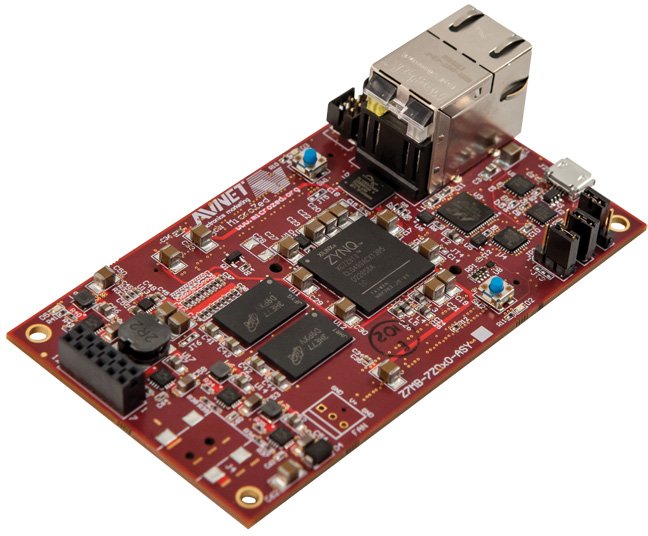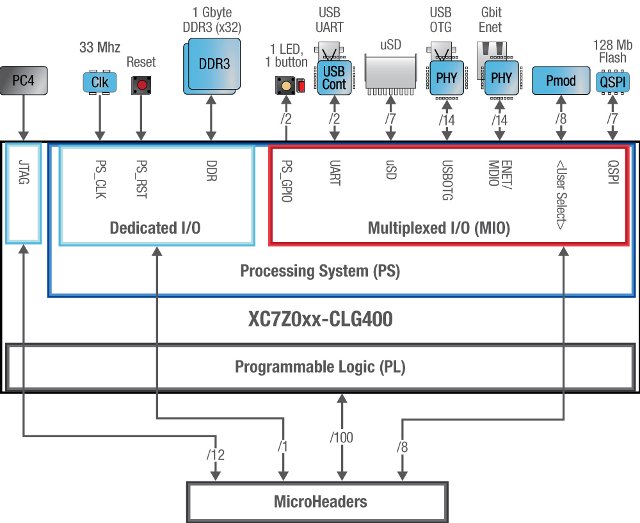ZedBoard is a low cost development board based on Xilinx Zynq-7020 SoC featuring two Cortex A9 cores and FPGA fabric, together with lots of ports and expansion I/Os, and running Linux. The problem is that “low cost” for this type of board still means $395 (or around $300 for academia), and you only get to this price because it’s been subsidized, and the normal price is actually $495… That’s why Avnet has just come with a new version of the evaluation kit called microZed that sells for $199 and targets applications such as general Zynq-7000 AP SoC evaluation and prototyping, embedded system-on-module (SOM) applications, embedded vision, test & measurement, motor control and software-defined radio.
 MicroZed technical specifications:
MicroZed technical specifications:
- SoC – Xilinx XC7Z010-1CLG400C (Zynq-7010)
- System Memory – 1 GB of DDR3 SDRAM
- Storage – 128 Mb of QSPI Flash + Micro SD card interface
- Connectivity
- 10/100/1000M Ethernet
- USB 2.0
- USB-UART
- User I/O (via dual board-to-board connectors) – 100 User I/O (50 per connector) configurable as up to 48 LVDS pairs or 100 single-ended I/O
- Misc
- 2×6 Digilent Pmod compatible interface providing 8 PS MIO connections for user I/O
- Xilinx PC4 JTAG configuration port
- PS JTAG pins accessible via Pmod
- 33.33 MHz oscillator
- User LED and push switch
- Power – 5V (USB UART) or 5V/12V (barrel jack or micro- header) AC/DC supply
- Dimensions –
The evaluation kit comes with the MicroZed board, a micro USB cable, a 4GB μSD card, Xilinx Vivado WebPACK license with Logic Analyzer (device locked), and a Getting Started card. The community provides full documentation including a getting started guide, hardware guides, schematics, bill of materials, PCB layout, and mechanical files. There are also a few training videos for both microZed in particular, and Xilinx Zynq in general. Strangely, I’m struggling to find details about Linux on the platform.
Let’s have a quick look at the difference with the Zedboard, and how they managed to cut costs. The main difference is whereas Zedboard is based on Zynq-7020, MicroZed is powered by Zynq-7010. The latter offers 28K logic cells, against the former 85K logic cells. Zynq-7010 has also about a third of Zynq-7020′s look-up tables (17,600 LUTs), extensible block RAM (240KB), programmable DSP slices (80), peak DSP performance (100 GMACs), and flip-flops (35,200). MicroZed has 1GB RAM instead of 512MB on Zedboard, so no cost cutting here, I presume. QSPI flash is smaller (128MB vs 256 MB), and MicroZed goes without many of the video and audio interfaces found in Zedboard.
As I mentioned previously, MicroZed evaluation kit costs $199 on Avnet, but the board can also be used like a system-on-modules on be bought for $192 (Zynq-7010 version) or $289 (Zynq-7020 version).
Via LinuxGizmos

Jean-Luc started CNX Software in 2010 as a part-time endeavor, before quitting his job as a software engineering manager, and starting to write daily news, and reviews full time later in 2011.
Support CNX Software! Donate via cryptocurrencies, become a Patron on Patreon, or purchase goods on Amazon or Aliexpress






“The latter offers 28K logic cells, against the latter 85K logic cells”
The second “latter” should be “former”
Where are the 100-Pin I/O connectors? Are the on the bottom of the board?
@FransM
Thanks. Updated.
@asciich.ch
Yes, they indicate the header are at the back in the picture at http://www.zedboard.org/sites/default/files/documentations/QSC-Z7MB-7Z010-G-v1d_0.pdf, but I can’t find a picture of the back of the board.
Details are available in the hardware user’s guide – http://www.zedboard.org/sites/default/files/documentations/MicroZed_HW_UG_v1_0.pdf
If you don’t mind waiting, $99 is a lot less expensive for the Parallella – and it comes with a 16-core accelerator:
http://shop.adapteva.com/collections/parallella/products/parallella-16
With the 7020 eventually available at $199. (Unless you kickstarted Parallella).
hello , is it possoble to build a CAN communication for this board ?
@hoacuong
I’m not 100% sure, but they mention a CAN interface in the hardware user guide linked above.
it may also be possible to use the FPGA fabric to design a CAN bus.
@hroth
True, but would people really be considering buying this mainly for the SOC? (I mean, isn’t it just another A9 dual core SOC?)
@hroth I can see two versions of Zynq-7010: CLG225 and CLG400 (Source: http://www.xilinx.com/publications/matrix/Product_Selection_Guide.pdf) MicroZed uses CLG400, but it’s not very clear which one Parallella uses, although the following post seems to confirm it’s CLG400: http://forums.parallella.org/viewtopic.php?f=23&t=78 If that’s the case the parallella does indeed look like a better deal. If you want to use GPIOs, it apparently costs $119. The parallella does not have “Pmod” connector. I really need to find out what it is for 🙂 @onebir Xilinx Zynq is not just a dual core Cortex A9, because there’s an FPGA inside, and the price reflects that: http://octopart.com/xc7z010-1clg400c-xilinx-27810849 . But… Read more »
@Jean-Luc Aufranc (CNXSoft)
Oh I see; I thought the FPGA was separate. Is the FGPA usable in the Parallella, or is it dedicated to dealing with the Epiphany chip? (= my guess at the reason for Parallella using an expensive SOC…)
Just received a tweet about an example use for Zynq SoCs: 4K2K or 8K2K video decoding: http://www.xilinx.com/applications/broadcast/digital-television.html?sf15525494=1
I’m not sure the model in MicroZed or Parallella is powerful enough, but still interesting to know practical applications.
I’ve got one of these – one thing to note is that all external connections to the FPGA fabric is through the headers on the bottom of the board. The PMOD is connected only to the ARM core’s perpherials.